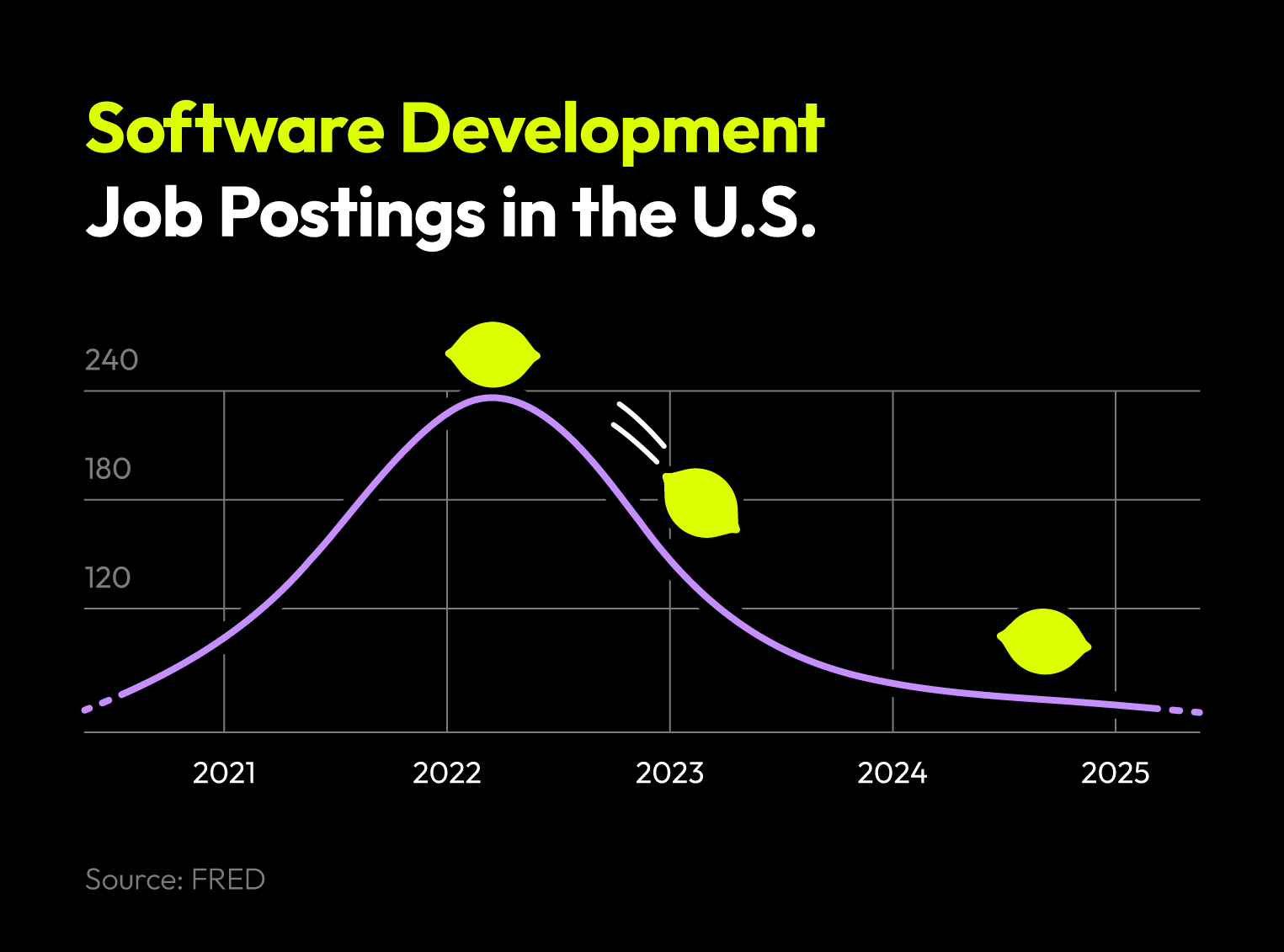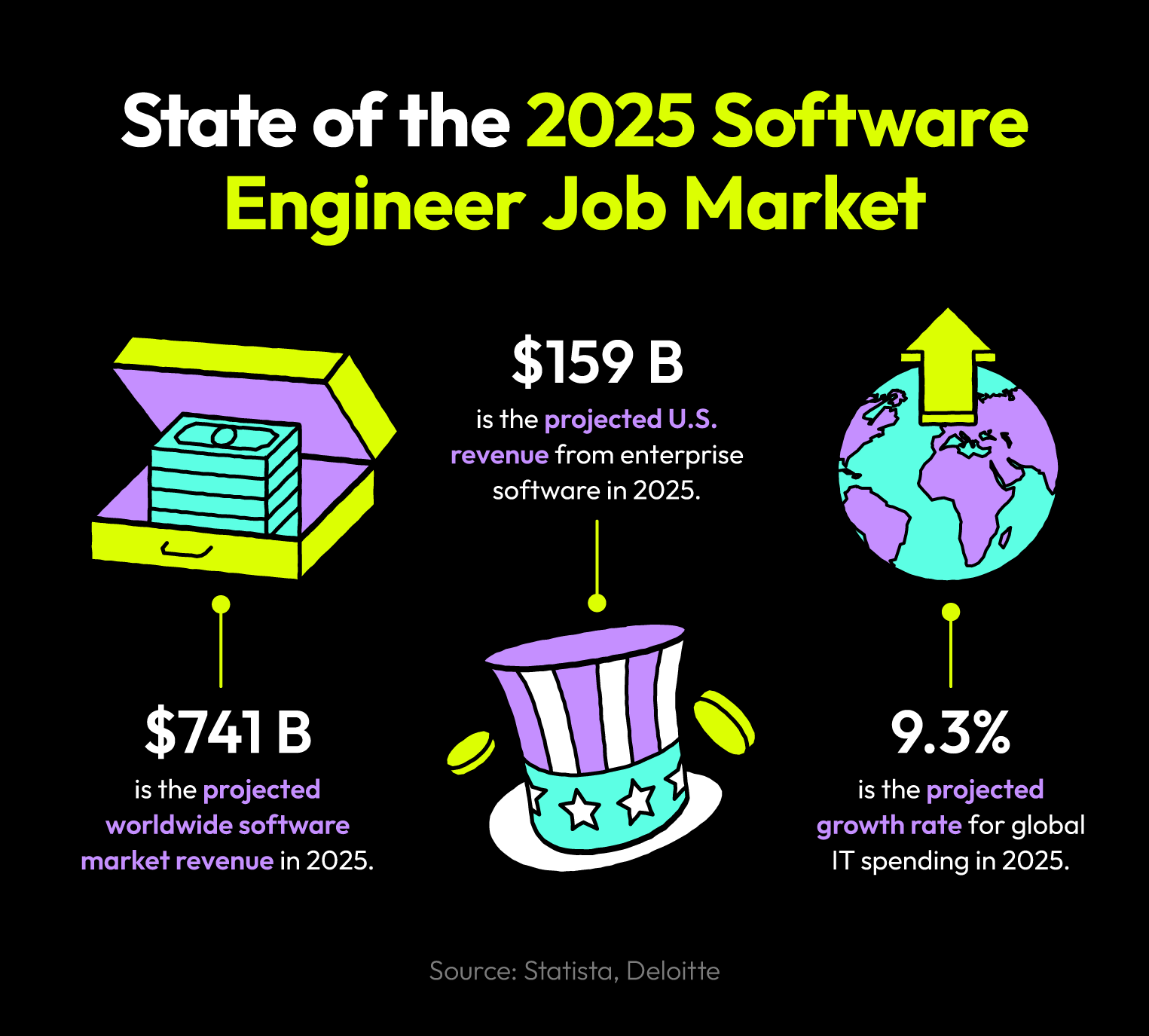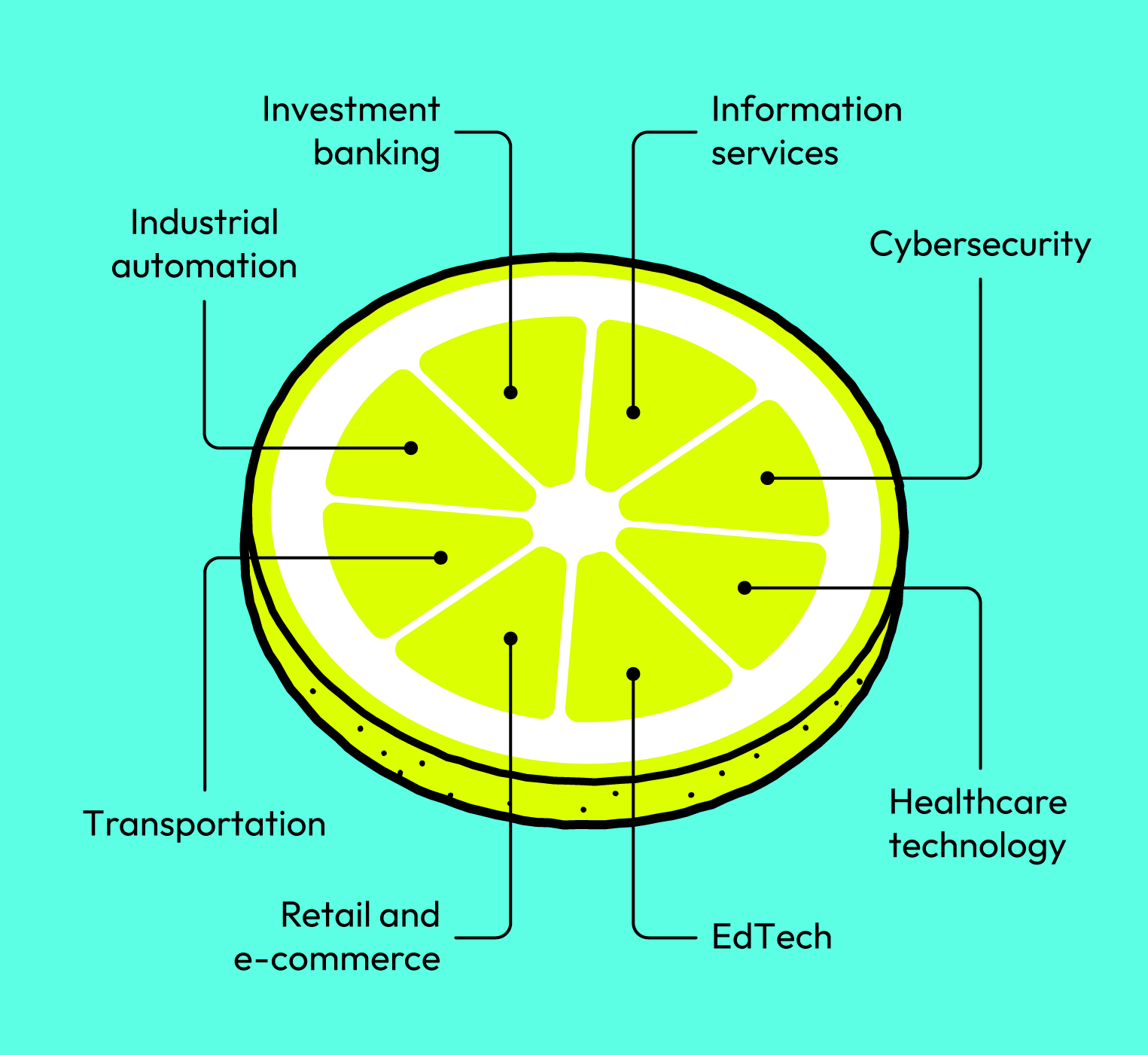Key Insight:
The software engineering job market in 2025 is stabilizing after a slow start, with demand shifting toward experienced developers and roles tied to AI and infrastructure. Software development roles are projected to grow 17% from 2023 to 2033, adding roughly 327,900 new jobs.
The software engineering job market in 2025 is full of opportunities, but that doesn’t mean finding the right role is easy.
Many developers are facing slower hiring timelines, mismatched expectations, and growing competition for the highest-paying engineering jobs as companies become more selective with their technical hires.
At the same time, businesses are struggling to ship quickly due to a shortage of qualified engineers. In this post, we’ll break down where the job market stands today, what skills are in demand, and what developers and hiring teams should expect as the landscape continues to shift.
How We Got Here: Key Shifts Over the Last 5 Years
The last five years have been anything but steady for software engineers.
The market started to shift after the 2021–2022 hiring boom, driven by rapid digital transformation and post-pandemic momentum. Roles that were once easy to find became harder to land, and employers began hiring more cautiously as economic pressures set in.
Mass layoffs at major tech firms have reshaped the hiring landscape. Companies like Microsoft, Amazon, and Google have trimmed their teams, slowing new job creation. Companies became more selective, prioritizing experienced engineers and those with AI skills over entry-level candidates.
At the same time, while developers still earn more than twice the U.S. median salary, their pay increases haven’t kept pace with the broader workforce, according to ADP Research.
Between January 2018 and January 2024, base pay for developers rose by 24%, compared to a 30% increase across all U.S. workers. As a result, demand dipped and salary growth followed.
That’s no coincidence, given how fast AI tools are changing workflows. Since early 2023, AI coding tools have attracted nearly $1 billion in funding, and developers using them report productivity gains of up to 35%. Employers are now actively seeking engineers who can integrate these tools into their daily work.
This shift has also pushed some companies to reconsider how they build teams, weighing the trade-offs of hiring a freelancer or a software development company for short-term or specialized projects.
So while the software engineering job market has cooled since its peak, it’s far from stagnant. It’s just evolving.

The State of the Software Market (Current Demand)
While global demand for digital tools and enterprise software continues to grow, the hiring market hasn’t kept pace, at least not yet.
Job openings for software developers hit a five-year low this year, signaling one of the slowest starts the industry has seen in recent years.
Still, there’s strong reason to believe demand will rebound in the second half of the year. According to Deloitte, analysts project global IT spending will grow by 9.3% in 2025, with software and data center segments expected to see the fastest gains.
The worldwide software market is also on track to hit $743 billion in revenue this year alone, with enterprise software accounting for more than $159 billion in U.S. revenue, more than any other country.
As digital infrastructure spending grows, so does demand for developers. According to Statista, the most in-demand roles include full-stack and back-end developers, followed by AI/ML specialists, front-end engineers, and DevOps professionals. The focus is shifting toward building scalable platforms, integrating AI tools, and improving operational efficiency.
That shift in priorities has also changed who gets hired. According to SignalFire’s State of Talent Report, new grads now account for just 7% of hires at Big Tech firms—down 25% from 2023.
At startups, the numbers are even lower—under 6% of hires are new grads. In a more cautious hiring climate, experience is winning.
With market confidence improving and long-term software spend on the rise, more companies may unfreeze hiring and seek out specialized developers to help them move faster in a still-competitive landscape.

Which Industries Will Need More Software Engineers?
Software developer was ranked the second best job in 2025 by U.S. News & World Report. Even with a slower start to the year, certain industries are doubling down on digital growth and will need more engineering talent to stay competitive.
Here are the top software engineering industries likely to hire in 2025:
- Investment banking: Financial firms are investing in advanced trading platforms and AI-driven risk tools. These systems rely on software engineers to manage money movement, portfolio performance, and compliance at scale.
- Industrial automation: Factories are adopting robotics, IoT, and smart systems to boost efficiency. Developers write the code that keeps devices connected and operations running seamlessly.
- Information services: Demand is growing for tools that can process and analyze it in real time. Cloud infrastructure, analytics platforms, and AI engines all need skilled hands to build and maintain them.
- Cybersecurity: The rise in cyber threats has made security a top priority. Developers in this space focus on building defenses, automating threat detection, and staying ahead of evolving risks.
- Transportation: From autonomous vehicles to logistics software, transportation is being reshaped by code. Engineers here work on routing algorithms, fleet management platforms, and vehicle intelligence systems.
- Healthcare technology: Telemedicine, wearables, and health data platforms are becoming standard. Developers are building the tools that support remote care, secure records, and smarter diagnostics.
- Retail and e-commerce: As online shopping evolves, so do the systems that power it. Personalized product recommendations, mobile apps, and seamless checkout experiences depend on reliable, flexible code.
- EdTech (education technology): Remote learning and digital classrooms continue to expand. Developers here build platforms that support content delivery, engagement tracking, and personalized learning.
These industries see software as a main growth driver. They’re looking for developers who can move fast, adapt to new tools, and work well in lean, tech-forward teams.

Trends Shaping the Future Job Market (Next 5-10 Years)
Today’s job market is just the beginning. Over the next decade, the software engineer growth rate will continue to shift, shaped by AI and global developer needs.
Long-Term Growth Outlook for Software Engineering
According to the U.S. Bureau of Labor Statistics, software development roles, including QA analysts and testers, are projected to grow 17% from 2023 to 2033, adding approximately 327,900 jobs. Many will replace retiring workers or those switching careers, not just fill new positions.
At the same time, global software revenue is expected to keep climbing. Analysts project nearly 5% annual growth from 2025 to 2030, reaching a market volume of over $403 billion by 2030.
Longer term, the global software market size could hit around $2.2 billion by 2034 if current trends continue, according to Precedence Research.
AI Is Reshaping Software Engineering Roles
Growth in the software industry doesn’t always mean more headcount. Some leaders, like Salesforce CEO Marc Benioff, have already suggested that AI may reduce the need to hire new engineers by boosting productivity.
In fact, Gartner predicts that through 2027, 80% of engineering teams will need to upskill to keep up with generative AI (GenAI) adoption and changing workflows.
This trend is already impacting how software developers operate. Deloitte found that 62% of developers now use AI coding tools, and nearly half of them use these tools daily.
As these platforms become more advanced, companies may prioritize engineers who can guide, supervise, and integrate AI systems instead of just writing every line of code from scratch.
The Rise of Global Hiring
We’re seeing a geographic shift in talent. GitHub reports significant growth in India, Africa, and Latin America, with India on track to have the largest developer population by 2028.
For remote teams, this global talent surge could shift the software developer job market and where companies source specialized skills.
In short, the demand for software engineers remains strong, but the qualities companies value most are evolving. Developers who stay curious, upskill often, and learn to work alongside AI will be best positioned to lead the next wave of software innovation.
Most In-Demand Software Engineering Roles
Certain roles continue to stand out in the software engineering job market as businesses prioritize speed, scalability, and AI integration.
Companies are actively hiring engineers who can manage infrastructure, build full platforms, and work with emerging technologies.
Machine Learning
Machine learning (ML) engineers build systems that learn from data and improve over time. These models analyze patterns, make predictions, and get more accurate as they process new information, powering everything from fraud detection to personalized recommendations.
This software engineer job often involves collaborating with data scientists and back-end teams to design, train, and maintain tools. They typically use frameworks like TensorFlow, PyTorch, and Scikit-learn to develop solutions for predictive maintenance, fraud prevention, and user personalization.
Top companies hiring ML engineers in 2025:
- Amazon
- Meta
- OpenAI
- Nvidia
Demand is also growing across industries like fintech, healthcare, and enterprise SaaS, where companies are applying ML to optimize operations and improve product outcomes.
DevOps
Development operations (DevOps) engineers improve software release speed, stability, and security by bridging the gap between development and operations. Their work helps teams scale efficiently and ship updates with fewer issues.
They often manage cloud infrastructure, write infrastructure as code (IaC), and maintain CI/CD pipelines to automate testing and deployment. Many also handle performance monitoring, security checks, and build internal tools to reduce downtime and prevent bugs.
Top companies hiring DevOps engineers include:
- AWS
- Google Cloud
- Microsoft
- IBM
- Atlassian
Startups and mid-sized tech firms are hiring DevOps engineers to speed up deployment and minimize downtime. Many teams now work across time zones and complex infrastructures, making this role even more essential.
Full-Stack Developers
Full-stack developers are versatile engineers with experience in both front-end and back-end systems. They can handle tasks like building user interfaces, managing servers, and working with databases, making them especially valuable for lean teams or early-stage startups.
They’re well-suited for fast-paced projects like building MVPs, developing platforms, or setting up APIs. However, complex or highly specialized work may still require support from dedicated front-end or back-end specialists.
Top companies hiring full-stack developers in 2025:
- Shopify
- Coinbase
- Dropbox
- HubSpot
- Slack
Startups and remote teams often rely on full-stack developers to move fast without growing a large team. Their ability to handle the entire tech stack makes them a go-to for early products, quick pivots, and end-to-end feature builds.
Backend Engineers
Back-end engineers focus on the server-side logic that powers websites and applications behind the scenes. They build APIs, manage databases, and keep systems stable, fast, and scalable to support smooth front-end performance.
This role often requires experience with coding languages like Python, Java, Ruby, or Node.js, along with knowledge of database systems and cloud platforms. Back-end engineers play a significant role in everything from user authentication to data storage and performance optimization.
Top companies hiring back-end engineers in 2025:
- Netflix
- Stripe
- Shopify
- Amazon
- Square
Startups and enterprise companies alike depend on back-end engineers to build the core infrastructure that keeps their apps running, especially as products grow more complex and data-heavy.
Tips for Hiring Qualified Software Engineers
Hiring the right software engineer starts with knowing what your business actually needs.
These software engineering recruitment tips can help you find developers who are the right fit for your goals and your team:
- Define your business’s needs: Clarify what you’re building and the type of technical support your team requires. Clear priorities make it easier to identify candidates with the right experience.
- Understand the role’s requirements: Be specific about the tools, experience level, and project scope. This will help candidates understand the expectations and save you time during the screening process.
- Source top talent from niche platforms: Job boards can bring in volume, but not always quality. Platforms like Lemon.io give you access to pre-vetted engineers who already match your stack and workflow.
- Prioritize skill and reliability over location: When your goal is to build a scalable, stable product, the developer’s location matters less than their ability to deliver. If there’s a few hours of timezone overlap and strong communication, distributed teams can move just as fast, sometimes faster, than local hires.
Clear role definitions and thoughtful sourcing help cut through hiring noise. Focusing on alignment from the start leads to stronger hires and faster onboarding.
Trends in Offshoring and Hiring Contractors
As demand for technical talent grows, more startups are turning to offshore developers to scale efficiently. As the global software market expands, outsourcing decisions now involve balancing speed, cost, and quality.
According to Verified Market Research, offshore development can significantly cut expenses, with some research suggesting up to 60% savings compared to on-site builds.
Understanding average freelance salaries is needed for businesses comparing in-house hires to global contractors, especially when trying to balance budget with engineering quality.
GitHub projects that India’s developer population will surpass the U.S. by 2028, and countries like Brazil, Nigeria, and the Philippines will also see rapid growth.
More businesses are also hiring talent outside the U.S., specifically Eastern European developers and other regions. This opens new talent pipelines for companies hiring globally and calls for more intentional onboarding and integration.
Hiring platforms and marketplaces are expanding access to global talent. However, many still rely on AI screening, which can overlook soft skills and team fit. Human-led vetting is becoming more important, especially when hiring software developers to join fast-paced teams.
Build a Better Software Team With Lemon.io
The software engineer job market is changing quickly as AI adoption grows and remote talent becomes more accessible. Success depends on building teams that can move fast and adapt to evolving technology.
A strong engineering team can help you launch sooner, scale smarter, and stay focused on what matters. Working with vetted remote developers gives you the flexibility to grow without compromising quality.
Start building with confidence by hiring software developers through Lemon.io today.










